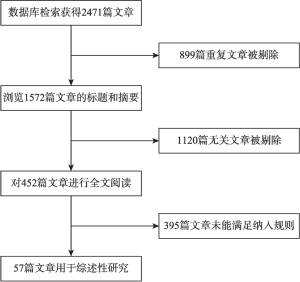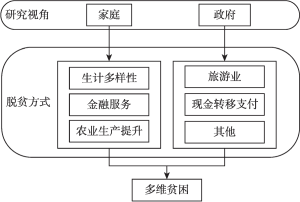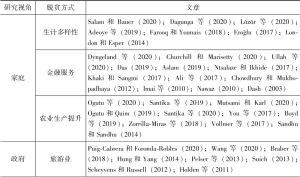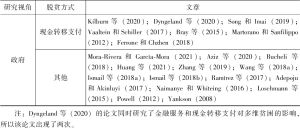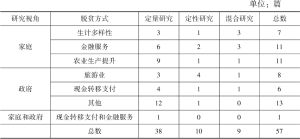摘要
本文从家庭和政府视角分析了不同脱贫方式对多维贫困的影响。家庭脱贫方式包括生计多样性、金融服务参与和农业生产提升,政府脱贫方式包括发展旅游业和现金转移支付项目。这些脱贫方式增加了家庭收入,进而缓解了家庭多维贫困。然而,由于一些欠发达地区市场不发达或公共服务供给不足,家庭收入增加对多维贫困的缓解效果不明显。本文认为,对于市场和公共服务发展完善的地区,上述脱贫方式可以有效缓解多维贫困,而对于市场和公共服务发展不完善的地区,上述脱贫方式的缓解效果则需要扶贫主体依据贫困家庭在各维度福利被剥夺的差异,直接对家庭提供特定的产品与服务可以更有效地缓解多维贫困。
作者
任义科 ,山西师范大学经济与管理学院教授,博士,研究方向为劳动经济学、弱势群体保护与发展等。
张立成 ,南京农业大学经济管理学院博士研究生,研究方向为产业经济学、农村多维贫困等。
杜海峰 ,男,四川巴中人。博士,教授,博士生导师。西安交通大学获机械电子工程博士,斯坦福大学博士后。现任西安交通大学公共政策与管理学院教授、博士生导师。主要跨学科研究中国社会转型期重大人口、社会经济问题,特别关注新型城镇化与集群行为等公共管理的现实问题及政策创新问题。近5年来主持课题12项(其中国家社科重大项目1项、重点项目2项,国家社科重大项目子项目2项),发表期刊论文130余篇。
- Adeoye,Ifeoluwa Damilola et al. 2019. “Effect of Off-Farm Income on Multidimensional Poverty among Rural Farm Households in Nigeria.” International Journal of Social Economics 9:1081-1094.
- Adepoju,Abimbola Oluyemisi and Oluwatofunmi Ibukun Akinluyi. 2017. “Multidimensional Poverty Status of Rural Households in Nigeria.” International Journal of Social Economics 8:1046-1061.
- Ali,Isahaque et al. 2017. “Microfinance as a Development and Poverty Alleviation Tool in Rural Bangladesh:A Critical Assessment.” Asian Social Work and Policy Review 1:4-15.
- Alkire,Sabina and James Foster. 2008. “Counting and Multidimensional Poverty Measurement.” OPHI Working Paper 7,Oxford Poverty Human Development Initiative.
- Alkire,Sabina and Andy Sumner. 2013. “Multidimensional Poverty and the Post-2015 Mdgs.” Development 1:46-51.
- Aslam,Mohammad. 2019. “Computation of Multidimensional Poverty Index:A Case Study.” International Journal of Emerging Trends in Engineering Research:262-267.
- Aziz,Yasir et al. 2020. “The Nexus between Zakat and Poverty Reduction,Is the Effective Utilization of Zakat Necessary for Achieving Sdgs:A Multidimensional Poverty Index Approach.” Asian Social Work and Policy Review 3:235-247.
- Bhuiyan,Abul Bashar et al. 2012. “Microfinance and Sustainable Livelihood:A Conceptual Linkage of Microfinancing Approaches Towards Sustainable Livelihood.” American Journal of Environmental Sciences 3:328.
- Bibi,Sami. 2005. “Measuring Poverty in a Multidimensional Perspective:A Review of Literature.” PEP Working Paper 7.
- Boyd,Emily et al. 2019. “The Ecological Limits Acting on Cocoa Smallholders and the Implications for Poverty Alleviation in an African Forest-Agriculture Landscape.” Frontiers in Sustainable Food Systems 3.
- Braber,Bowy den et al. 2018. “Impact of Protected Areas on Poverty,Extreme Poverty,and Inequality in Nepal.” Conservation Letters 6.
- Bray,DavidBarton et al. 2015. “Can Payments for Environmental Services Strengthen Social Capital,Encourage Distributional Equity,and Reduce Poverty?” Conservation and Society 4.
- Bucheli,José R.et al. 2018. “Paths to Development?Rural Roads and Multidimensional Poverty in the Hills and Plains of Nepal.” Journal of International Development 3:430-456.
- Chowdhury,Tamgid Ahmed and Pundarik Mukhopadhaya. 2012. “Assessment of Multidimensional Poverty and Effectiveness of Microfinance-Driven Government and Ngo Projects in the Rural Bangladesh.” The Journal of Socio-Economics 5:500-512.
- Churchill,Sefa Awaworyi and Vijaya Bhaskar Marisetty. 2020. “Financial Inclusion and Poverty:A Tale of Forty-Five Thousand Households.” Applied Economics 16:1777-1788.
- Dagunga,Gilbert et al. 2020. “To What Extent Should Farm Households Diversify?Implications on Multidimensional Poverty in Ghana.” World Development Perspectives,vol.20:100264.
- Dang,Ai-Thu. 2014. “Amartya Sen’s Capability Approach:A Framework for Well-Being Evaluation and Policy Analysis?” Review of Social Economy 4:460-484.
- Das,Tiken. 2019. “Does Credit Access Lead to Expansion of Income and Multidimensional Poverty?A Study of Rural Assam.” International Journal of Social Economics 2:252-270.
- Dash,Anup. 2003. “13. Strategies for Poverty Alleviation in India:Cysd’s Holistic Approach to Empowerment through the Self-Help Group Model.” IDS Bulletin 4:133-142.
- Dyngeland,C.et al. 2020. “Assessing Multidimensional Sustainability:Lessons from Brazil’s Social Protection Programs.” Proc.Natl.Acad.Sci.U.S.A. 34:20511-20519.
- Eroĝlu,Şebnem. 2017. “Income Generation,Informality and Poverty in Urban Turkey.” International Journal of Sociology and Social Policy 37(516):295-310.
- Espinoza-Delgado,José and Stephan Klasen. 2018. “Gender and Multidimensional Poverty in Nicaragua:An Individual Based Approach.” World Development,vol.110:466-491.
- Farooq,Shujaat and Zunaira Younais. 2018. “Do Non-Farm Enterprises Offer Pathways for Upward Mobility in Rural Pakistan?Evidence from Panel Dataset.” The Pakistan Development Review 2:203-221.
- Ferrone,Lucia and Yekaterina Chzhen. 2018. “How to Reach the Sustainable Development Goal 1.2?Simulating Different Strategies to Reduce Multidimensional Child Poverty in Two Middle-Income Countries.” Child Indicators 3:711-728.
- Fonta,William M.et al. 2019. “Multidimensional Poverty Assessment among Adolescent Children in the Mouhoun Region of Burkina Faso,West Africa.” Child Indicators Research 4:1287-1318.
- Fransman,Tina and Derek Yu. 2019. “Multidimensional Poverty in South Africa in 2001-16.” Development Southern Africa 1:50-79.
- Holden,Andrew et al. 2011. “Tourism and Poverty Reduction:An Interpretation by the Poor of Elmina,Ghana.” Tourism Planning & Development 3:317-334.
- Huang,Fubin et al. 2021. “Exploring Rural Energy Choice from the Perspective of Multidimensional Capabilities:Evidence from Photovoltaic Anti-Poverty Areas in Rural China.” Journal of Cleaner Production,vol.283:124586.
- Hung,Kam and Xiaotao Yang. 2014. “Poverty Alleviation Via Tourism Cooperatives in China:The Story of Yuhu.” International Journal of Contemporary Hospitality Management 6:879-906.
- Hussain,Intizar and Munir A Hanjra. 2004. “Irrigation and Poverty Alleviation:Review of the Empirical Evidence.” Irrigation and drainage 1:1-15.
- IFAD. 2016. “Ifad Strategic Framework 2016-2025.” Accessed.April 7. https://www.ifad.org/en/web/knowledge/-/ifad-strategic-framework-2016-20-1.
- Imai,Katsushi S.et al. 2010. “Microfinance and Household Poverty Reduction:New Evidence from India.” World Development 12:1760-1774.
- Ismail,Mohd Khairi et al. 2018a. “The Role of Agropolitan Project in Eradicating Poverty:Multidimensional Poverty Index.” International Journal of Engineering & Technology 4:443-450.
- Ismail,Mohd Khairi et al. 2018b. “Gahai Agropolitan Project in Eradicating Poverty:Multidimensional Poverty Index.” Planning Malaysia,vol.16.
- Jolliffe,Dean and Espen Beer Prydz. 2016. “Estimating International Poverty Lines from Comparable National Thresholds.” The Journal of Economic Inequality 2:185-198.
- Khaki,Audil Rashid and Mohi-ud-Din Sangmi. 2017. “Does Access to Finance Alleviate Poverty?A Case Study of Sgsy Beneficiaries in Kashmir Valley.” International Journal of Social Economics 8:1032-1045.
- Kilburn,Kelly et al. 2020. “The Impact of a Conditional Cash Transfer on Multidimensional Deprivation of Young Women:Evidence from South Africa’s Htpn 068.” Social Indicators Research,vol.151:865-895.
- Kim,Hoolda. 2019. “Beyond Monetary Poverty Analysis:The Dynamics of Multidimensional Child Poverty in Developing Countries.” Social Indicators Research 3:1107-1136.
- Kwon,Huck-ju and Eunju Kim. 2014. “Poverty Reduction and Good Governance:Examining the Rationale of the Millennium Development Goals.” Development and Change 2:353-375.
- Lade,S.J.,Haider,L.J.,Engström,G.,& Schlüter,M. 2017. “Resilience Offers Escape from Trapped Thinking on Poverty Alleviation.” Science Advances 5,e1603043.
- Lázár,Attila N et al. 2020. “Modelling Household Well-Being and Poverty Trajectories:An Application to Coastal Bangladesh.” Plos One 9.
- Li,Guie et al. 2019. “Multidimensional Poverty in Rural China:Indicators,Spatiotemporal Patterns and Applications.” Social Indicators Research:1099-1134.
- Li,Yan et al. 2018. “A Review of Photovoltaic Poverty Alleviation Projects in China:Current Status,Challenge and Policy Recommendations.” Renewable and Sustainable Energy Reviews,vol.94:214-223.
- London,T. and H.Esper. 2014. “Assessing Poverty-Alleviation Outcomes of an Enterprise-Led Approach to Sanitation.” Annals of the New York Academy of Sciences,vol.1331:90-105.
- Loschmann,Craig et al. 2015. “Does Shelter Assistance Reduce Poverty in Afghanistan?” World Development,vol.74:305-322.
- Martorano,Bruno and Marco Sanfilippo. 2012. “Innovative Features in Poverty Reduction Programmes:An Impact Evaluation of Chile Solidario on Households and Children.” Journal of International Development 8:1030-1041.
- Maulu,Sahya et al. 2021. “Enhancing the Role of Rural Agricultural Extension Programs in Poverty Alleviation:A Review.” Cogent Food & Agriculture 1.
- Mohamed,Erna Farina and Neneng Ela Fauziyyah. 2020. “Islamic Microfinance for Poverty Alleviation:A Systematic Literature Review.” International Journal of Economics,Management and Accounting 1:141-163.
- Moher,D.et al. 2009. “Preferred Reporting Items for Systematic Reviews and Meta-Analyses:The Prisma Statement.” Plos Medicine 7.
- Mora-Rivera,Jorge and Fernando García-Mora. 2021. “Internet Access and Poverty Reduction:Evidence from Rural and Urban Mexico.” Telecommunications Policy 2.
- Moyer,Jonathan D and Steve Hedden. 2020. “Are We on the Right Path to Achieve the Sustainable Development Goals?” World Development,vol.127.
- Mutsami,Chrispinus and Stephen Karl. 2020. “Commercial Rabbit Farming and Poverty in Urban and Peri-Urban Kenya.” Frontiers in Veterinary Science,vol.7:353.
- Naimanye,Andrew Grace and Tony Whiteing. 2016. “Poverty-Centred Rural Road Funds Sharing in Sub-Saharan Africa.” Proceedings of the Institution of Civil Engineers-Transport,vol.169,Thomas Telford Ltd:387-396.
- Nawaz,Shah. 2010. “Microfinance and Poverty Reduction:Evidence from a Village Study in Bangladesh.” Journal of Asian and African Studies 6:670-683.
- Nguyen,Cuong Viet et al. 2021. “Do Good Governance and Public Administration Improve Economic Growth and Poverty Reduction?The Case of Vietnam.” International Public Management Journal 1:131-161.
- Ntsalaze,Lungile and Sylvanus Ikhide. 2017. “The Threshold Effects of Household Indebtedness on Multidimensional Poverty.” International Journal of Social Economics 11:1471-1488.
- Ogutu,Sylvester Ochieng et al. 2020. “Supermarket Contracts and Smallholder Farmers:Implications for Income and Multidimensional Poverty.” Food Policy,vol.95.
- Ogutu,Sylvester Ochieng and Matin Qaim. 2019. “Commercialization of the Small Farm Sector and Multidimensional Poverty.” World Development,vol.114:281-293.
- Owusu-Addo,E.et al. 2016. “The Impact of Cash Transfers on Social Determinants of Health and Health Inequalities in Sub-Saharan Africa:A Systematic Review Protocol.” Health Policy Plan 5:675-696.
- Pelser,André et al. 2013. “Protected Areas as Vehicles in Population Development:Lessons from Rural South Africa.” Environment,Development and Sustainability 5:1205-1226.
- Pickering,Catherine and Jason Byrne. 2014. “The Benefits of Publishing Systematic Quantitative Literature Reviews for Phd Candidates and Other Early-Career Researchers.” Higher Education Research & Development 3:534-548.
- Powell,Lesley. 2012. “Reimagining the Purpose of Vet-Expanding the Capability to Aspire in South African Further Education and Training Students.” International Journal of Educational Development 5:643-653.
- Puig-Cabrera,Miguel and Concepción Foronda-Robles. 2020. “The Phenomenon of Tourism Poverty Trap:Is It Possible That Tourism Breaks the Vicious Circle of Poverty in Emerging Destinations?” Journal of Poverty 4:334-353.
- Ramírez,Juan Mauricio et al. 2017. “Property Tax Revenues and Multidimensional Poverty Reduction in Colombia:A Spatial Approach.” World Development,vol.94:406-421.
- Salam,Shakila and Siegfried Bauer. 2020. “Rural Non-Farm Economy and Livelihood Diversification Strategies:Evidence from Bangladesh.” GeoJournal:1-13.
- Sandhu,Harpinder and Sukhbir Sandhu. 2014. “Linking Ecosystem Services with the Constituents of Human Well-Being for Poverty Alleviation in Eastern Himalayas.” Ecological Economics,vol.107:65-75.
- Santika,Truly et al. 2019. “Does Oil Palm Agriculture Help Alleviate Poverty?A Multidimensional Counterfactual Assessment of Oil Palm Development in Indonesia.” World Development,vol.120:105-117.
- Santika,Truly et al. 2020. “Impact of Palm Oil Sustainability Certification on Village Well-Being and Poverty in Indonesia.” Nature Sustainability,vol 2:109-119.
- Scheyvens,Regina and Matt Russell. 2012. “Tourism and Poverty Alleviation in Fiji:Comparing the Impacts of Small-and Large-Scale Tourism Enterprises.” Journal of Sustainable Tourism 3:417-436.
- Sen,Amartya. 1993. “Capability and Well-Being 73.” The Quality of Life,vol.30:270-293.
- Sen,Amartya. 1983. “Poor,Relatively Speaking.” Oxford Economic Papers 2:153-169.
- Sen,Amartya. 1976. “Poverty:An Ordinal Approach to Measurement.” Econometrica:Journal of the Econometric Society:219-231.
- Singh,Pramod K and Harpalsinh Chudasama. 2020. “Evaluating Poverty Alleviation Strategies in a Developing Country.” Plos One 1.
- Song,Sophie and Katsushi S Imai. 2019. “Does the Hunger Safety Net Programme Reduce Multidimensional Poverty?Evidence from Kenya.” Development Studies Research 1:47-61.
- Stevenson,James R and Xavier Irz. 2009. “Is Aquaculture Development an Effective Tool for Poverty Alleviation?A Review of Theory and Evidence.” Cahiers Agricultures 2-3:292-299 (291).
- Suich,Helen. 2013. “Evaluating the Household Level Outcomes of Community Based Natural Resource Management:The Tchuma Tchato Project and Kwandu Conservancy.” Ecology and Society 4.
- Thorbecke,Erik. 2013. “Multidimensional Poverty:Conceptual and Measurement Issues.” Paper Prepared for The Many Dimensions of PovertyInternational Conference,UNDP·Interonational Poverty Centre,Brasilia,August 29-31,2005.
- Tranfield,David et al. 2003. “Towards a Methodology for Developing Evidence-Informed Management Knowledge by Means of Systematic Review.” British Journal of Management 3:207-222.
- Ullah,Kifayat et al. 2020. “Financial Inclusion,Socioeconomic Disaster Risks and Sustainable Mountain Development:Empirical Evidence from the Karakoram Valleys of Pakistan.” Sustainability 22.
- United Nations. 2020. “The Sustainable Development Goals Report 2020.” Accessed April 7. https://unstats.un.org/sdgs/report/2020/.
- United Nations Development Programme. 2010. “Human Development Report 2010:The Real Wealth of Nations-Pathways to Human Development.” Accessed April 7. https://hdr.undp.org/en/content/human-development-report-2010.
- United Nations Development Programme. 2020. “Human Development Report 2020:The Next Frontier—Human Development and the Anthropocene.” Accessed April 7. https://hdr.undp.org/en/2020-report.
- Vaaltein,Sive and Ulene Schiller. 2017. “Addressing Multi-Dimensional Child Poverty:The Experiences of Caregivers in the Eastern Cape,South Africa.” Children and Youth Services Review,vol.76:227-236.
- Vollmer,Frank et al. 2017. “Charcoal Income as a Means to a Valuable End:Scope and Limitations of Income from Rural Charcoal Production to Alleviate Acute Multidimensional Poverty in Mabalane District,Southern Mozambique.” World Development Perspectives,vol.7-8:43-60.
- Wang,Kai et al. 2020. “Poor Residents’ Perceptions of the Impacts of Tourism on Poverty Alleviation:From the Perspective of Multidimensional Poverty.” Sustainability 18.
- Wang,Wenlue et al. 2018a. “Impact of the Ecological Resettlement Program on Participating Decision and Poverty Reduction in Southern Shaanxi,China.” Forest Policy and Economics,vol.95:1-9.
- Wang,Yanhui et al. 2018b. “Village-Level Multidimensional Poverty Measurement in China:Where and How.” Journal of Geographical Sciences 10:1444-1466.
- World Bank. 2001. World Development Report 2000/2001:Attacking Poverty. New York:Oxford University Press.
- World Bank. 2020. “World Development Report 2020:Trading for Development in the Age of Global Value Chains.” Accessed April 7. https://www.worldbank.org/en/publication/wdr 2020.
- World Tourism Organization. 2017. UNWTO Annual Report 2017. UNWTO,Madrid. https://www.e-unwto.org/doi/book/10.18111/9789284419807.
- Yankson,Paul WK. 2008. “Decentralisation and Poverty Reduction in the Gomoa District of Ghana.” Norsk Geografisk Tidsskrift-Norwegian Journal of Geography 3:230-240.
- You,Jing et al. 2017. “Identifying a Sustained Pathway to Multidimensional Poverty Reduction:Evidence from Two Chinese Provinces.” The Journal of Development Studies 1:137-158.
- Zhang,Huiming et al. 2019. “Multi-Dimensional Poverty Measurement for Photovoltaic Poverty Alleviation Areas:Evidence from Pilot Counties in China.” Journal of Cleaner Production,vol.241.
- Zorrilla-Miras,Pedro et al. 2018. “Environmental Conservation and Social Benefits of Charcoal Production in Mozambique.” Ecological Economics,vol.144:100-111.


